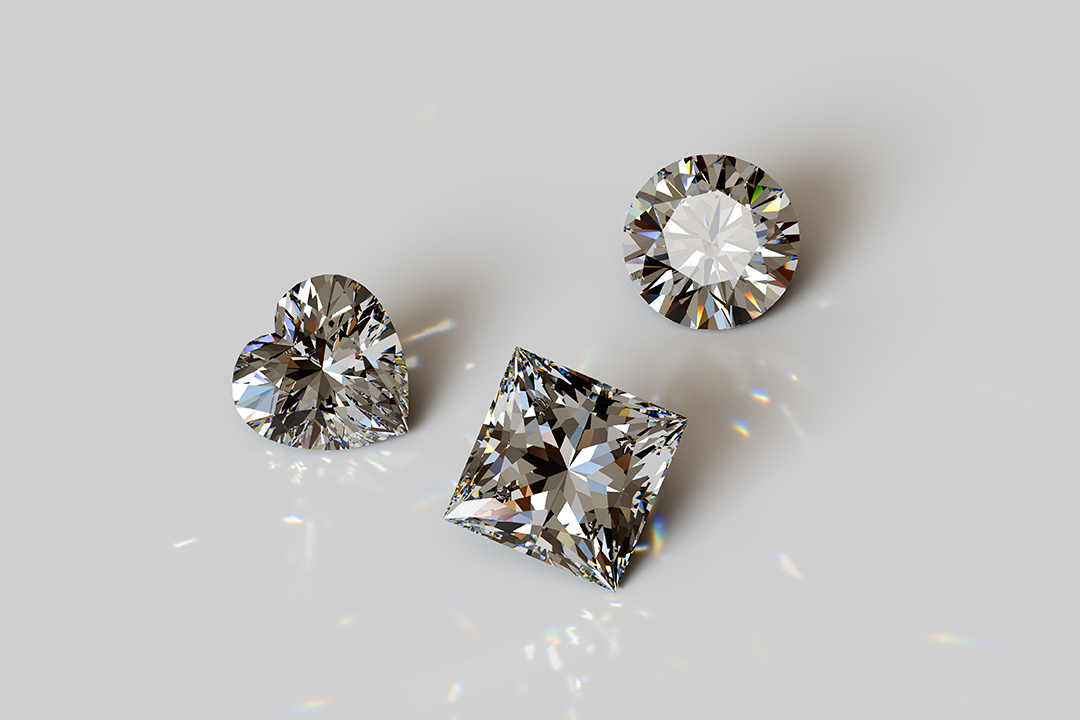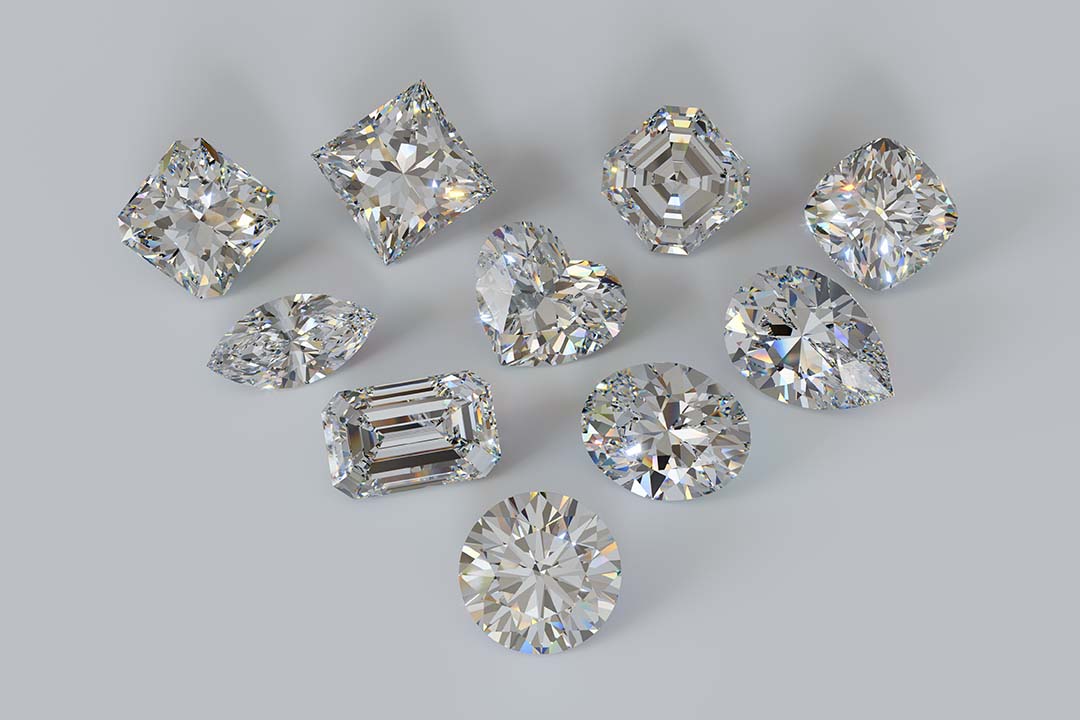- Home
- /
- Diamond education
- /
- Diamond 4Cs
- /
- Diamond Cut
The Ultimate Guide to Diamond Cut
May 03, 2023

Diamond cut is one of the all-important “Four Cs” of diamond grading. It influences many aspects of your diamond, and poor-quality cuts can leave you with a dull, lifeless stone. Many people confuse cut with shape and assume it means things like round, oval, emerald, and so on, but cut is a separate value. According to the GIA, it’s one of the most difficult aspects to analyze, as it involves proportions, facets, and light play.
Suffice it to say, a diamond’s cut is incredibly important! To understand more about this fascinating measurement and how it affects the look of your diamond, keep reading.
What is a Diamond Cut?
Diamond cut is how light interacts with the facets of each diamond. You can’t have things like diamond fire, scintillation, and brilliance with a poorly cut diamond. Diamond cut involves factors such as:
- Symmetry
- Proportions
- Polish
All diamonds are cut with certain facets and angles that allow light into the stone. Light reflects and refracts as it interacts with those facets, ultimately creating the coveted “sparkle” effect. Diamond cuts are graded with one of five options: Excellent, Very Good, Good, Fair, or Poor. By selecting anything below a Very Good grade, you run the risk of having a dark, dull stone, as its facets are either poorly sized, not symmetrical, and generally don’t interact well with light.

Why Is It Important?
There’s no fire, brilliance, scintillation, or sparkle without the cut! When you look at a diamond and fall in love with the way it catches the light, whether it shows as flashes of white and shadow or an array of rainbow colors, you’re admiring the cut. Diamonds with excellent, high-quality cuts have the most sparkle, while poor craftsmanship leaves you with something dull and uninspiring.
In essence, the qualities that most people adore in diamonds come from the cut. There’s a reason it’s one of the Four Cs, and in some ways, it’s the most important! You simply can’t have a gorgeous diamond with a bad cut.
Types of Diamond Cuts and Their Differences
There are two common diamond cut styles today: step cut and brilliant cut. Mixed-cut diamonds incorporate elements from both styles. While there are other historical and vintage cuts, modern-day diamonds typically always fall into one of the categories mentioned above. There are some important differences between brilliant and step cuts, and you’ll see why certain shapes pair well with a particular type of cut.
Step Cut
Step-cut diamonds have rectangular facets. When you look at them, they have a sort of “staircase” quality, ascending to the crown and descending toward the pavilion of the diamond. Step-cut diamonds have a very unique look and it’s showcased best in shapes like emerald and baguette-cut diamonds.
Step cuts are more subtle than the brilliant cuts discussed below. There’s a certain elegance to step cuts, and it’s a great way to show off your stone’s clarity. They don’t have quite as much sparkle as a round-cut diamond, so choose a cut that reflects your personal style and has the qualities you value.

Brilliant Cut
Can you say sparkle? If you’ve found yourself mesmerized by the slow-turn of a glittering, sparkling diamond on a commercial or in a jewelry store, you were probably looking at a brilliant cut. Brilliant-cut round diamonds are the most popular type of stone around. You’ll get a lot of fire, brilliance, and scintillation with a brilliant cut.
The facets in a brilliant-cut diamond are shaped like triangles or kites, and they’re excellent at creating a lot of light play within the stone. A brilliant cut has a higher number of facets overall than the step cut, so light disperses and reflects many times. Round and princess cuts are well-known for this type of cut and show what it’s capable of.

What is the Difference Between Diamond Cut and Diamond Shape?
Cut and shape are often used interchangeably when people discuss diamonds, but they are quite different. A diamond’s shape is essentially its outline, while the diamond cut is its facets, symmetry, and interaction with light.
The terminology can be confusing, especially when the word “cut” is typically tacked onto the end of a diamond’s shape. For instance, you’re probably accustomed to seeing (or hearing) things like: Emerald-cut diamond, Marquise-cut diamond, Princess-cut diamond, Oval-cut diamond, and etc.

In reality, those are all shapes. Think of it like this - if you were to draw your favorite diamond on a piece of paper, you would begin with an outline of the outer edge. In the simplest terms, that’s the diamond’s shape. It might look like a heart, a pear, an oval, and so on. In comparison, the cut is more akin to the inner workings of the stone. You can have a brilliant-cut round diamond, a step-cut emerald diamond, and other combinations. Shape and cut work closely together, but they are not the same thing.
What is the Most Popular Diamond Cut?
This one is simply no contest. By a large margin, the round brilliant-cut diamond is the most popular. It has a high number of facets, meaning it has a lot of sparkle and “curb appeal.” Anyone after an eye-catching stone with a lot of moving light will likely reach for a round brilliant cut.
Given that Princess-cut diamonds, also in the brilliant-cut family, come in toward the top of the list, it’s safe to say that people love a great brilliant cut! However, the best diamond is always the one that you prefer. Trends come and go, but you should feel happy when you see your stone. If you love the depth and intrigue of a step-cut diamond, don’t let the masses sway you.
Conclusion
Diamond cut is a critical feature of any stone, yet it’s perhaps the most misunderstood of the Four Cs. Just remember, if you’re searching for sparkle (or don’t see it when you look at a diamond), you’re evaluating its cut. For the “wow” factor, you want an Excellent or Very Good cut.

















